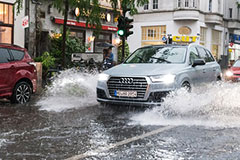Identifying Flood Damaged Cars - Vol.377
Used car dealerships may sell cars that are flood damaged. Even though the dealership may be hundreds of miles away from any flood, you may still end up with a flood-damaged car. This is because some used car traders ship these cars to other regions to "erase the issue." Don't worry, most dealers are honest and will ensure the vehicle is identified as 'Flood Damaged' or 'Demolition'. However, there are dealers who will try to sell a flood-damaged vehicle while leaving potential buyers in the dark about the water damage.

Flood damage impacts many places on a vehicle, often eating away from the inside out. So, there is a list of parts to inspect on a vehicle to find signs of flood damage. It's crucial to carefully examine a vehicle for signs of flood damage, however, this is easier said than done because problems may only occur down the line.
Where Damage Can Occur
As mentioned earlier, vehicles can have damage eating away at areas of the car for months and even years, before the damage becomes visible. Flooding can cause the seizing up of mechanical systems through rust and corrosion, as well as affecting lubricants that would ordinarily never mix with water or debris particles.
Furthermore, the electrical systems we all rely on to keep us safe can slowly deteriorate without our knowledge. Cars use a variety of electrical systems including, power steering cables and airbag controls, all of which are susceptible to flood damage. Paint is equally vulnerable and can erode from water becoming trapped under tiny cracks or fissures that naturally occur as paint ages, or if the car is submerged for a prolonged period of time.
What to Look For
Used car dealerships will always inspect new vehicles before bringing them to their lots. Flood damage inspection needs to be more thorough than a standard inspection. Even if your dealership is a long way from any flooding, all vehicles coming in after a major flood, should undergo a flood damage inspection. There are many warning signs that will tell you to investigate further.
Check the carpets and floor coverings, front and back, and in the trunk. Look for rust and mud, particularly on the underside of these. Also, smell the underside for tell-tale odors like mold or mildew. Furthermore, check the flooring under the covers for signs of debris, mud, and water stains.
Rust on exposed screw heads may point to flood damage, so make sure to inspect them carefully. Check where the paint meets metal on the underside of the car and while there, look to see if any of the rubber drain plugs have recently been taken out and put back or replaced.
Then, you need to inspect the hard to clean places, like the underside of the hood and the trunk. Keep an eye out for mud and debris that may be stuck there. Also, check the panels and brackets throughout the car for any bits of mud and debris that may have lodged there.
Summary
Any car that comes into a used car dealership after a major flood- even if this dealership is a great distance away from the flood site - should be diligently and aggressively inspected for signs of flood damage If you find signs of water damage but the vehicle is not identified as 'Flood Damaged' or 'Demolition', then you have to assume that the car dealer is misrepresenting its status.
It is up to you to ensure there are no signs of flood damage prior to making the purchase and a thorough inspection will produce the information you need.